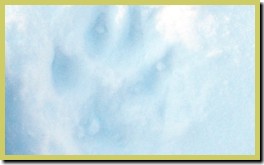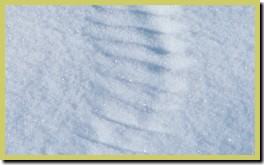
Tracks in the snow
A New Winter ActivityThere’s more to do in winter than just sit at your kitchen table with a mug of coffee and stare out at your snow-covered yard. You can bundle up and go outside to look at your snow-covered garden. Why? To see who or what has been in your garden . . . by the tracks they leave in the snow. Winter’s blanket of snow insulates the ground below, sparing your perennials from the worst of winter’s cold and provides a ready source of slow-release water in the spring. Snow also acts like a pressure-sensitive photographic plate, recording everything that happens to it. You can use this feature of snow to glimpse into the winter-time lives of animals in your garden. The tracks that most animals leave in the snow are as distinctive as the animals themselves. With practice and some help from a good tracking guide, you can identify the animals that include your yard in their winter habitat. Olaus J. Murie's “A Field Guide to Animal Tracks”, in the Peterson Field Guide Series, is one of the best books to get you started. Or you can just check out NatureNorth's: Makin'Tracks! - A guide to tracking Manitoba's animals. |
||
Do some sleuthingThink of every set of tracks as a mystery. What animal made the tracks? Where did it come from? Where was it going and what was it doing? Interpreting tracks in the snow is fun and can earn you new insights into the lives of your local wildlife, and not just in your yard. Tracking can be a fun activity on walks or while cross-country skiing or any time you’re outdoors in winter.
Sometimes the way the prints are arranged gives a key to the animal’s identity. A big grey squirrel has feet about the same size and shape as a small cottontail rabbit. The difference in their tracks will be the arrangement of their four feet. Both animals usually hop along, pushing off with their hind feet placed side by side. They land with their smaller front feet first, which push off before the hind feet land, so the hind feet touch down beyond the marks left by the front feet. A squirrel places its front feet side by side. A rabbit places its front feet in line, one in front of the other. The tracks of deer mice and house mice look like tiny squirrel tracks as they hop along with their front feet placed side by side. Drag marks of their long tails help to identify them. Voles, relatives of mice, but with short ears and very short tails, leave similar tracks, but with no tail drag. Mice and other small mammals, like shrews, often burrow right through the snow, sometimes leaving small tunnels or tunnel entryways for us to see. |
||
|
||
BIrds leave tracks, too
Keep a sharp eye for other signs that might let you know what the animal was doing, other than walking or hopping through your yard. Look for chewed stems or buds, or peck marks where seeds have been picked up. The more closely you look at the signs animals leave behind, the more you will learn about the wildlife that shares your neighbourhood. In ClosingSo don’t just sit and wait for winter to be over. Get out and enjoy it, in your garden or wherever you take a winter’s walk. And for a new winter activity, give tracking a try.
|
||
|
More on tracking in NatureNorth: Makin' Tracks | Tracks in the Class Room |
| You can help NatureNorth produce more great articles with a secure donation through PayPal. Our Google Adsense ads pay our server costs, but that's about it. To learn more follow this link: Support NatureNorth. Thank-you! | |


